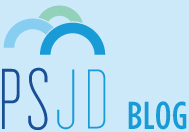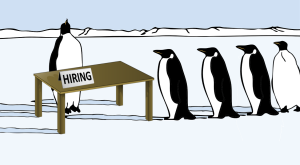You Need A Montage: Informational Meetings Scene III (Following Through and Following Up)
Sam Halpert, PSJD Fellow 2014 – 2015
Christina Jackson, Director of Public Interest Initiatives and Fellowships
(with thanks to the professional development teams at UC Berkeley, Washington and Lee, and Seattle University Law Schools)
Okay, grasshoppers. Last month, I confessed my job search skills are weak and committed to questing with you to learn from PSJD’s resident career development guru Christina Jackson. Since then, we’ve re-made our resumes and cover letters. This week, we’ve begun the real work, for to master the art of informational meetings we must remake ourselves.
Creating a Strategy for Informational Meetings (Tip 5)
It’s been a busy week, on Monday, we covered the first step in our strategy—identifying contacts. Wednesday, we talked about reaching out to request a meeting. If you haven’t worked through those posts already, go back and make sure you’re up to speed before starting on this one.
Ready? Okay. You’ve identified your network of meeting candidates and you’ve made your initial contacts. Now, we need to talk about what it takes to get good insights from a meeting, make a successful connection with the person you speak with, and make that connection stick. (I’ve done many informational meetings, but I haven’t had the benefit of trying it with a game plan like this, so I don’t have examples for you. We’ll just have to go through this process together.) After reading this post, you should be able to prepare a strategy for the informational meetings you’re planning with your contacts and for following up with those contacts after your meeting happens.
NB: Don’t forget to check out the Google Drive spreadsheet tool I’m using to organize my own informational meeting efforts. I’m planning to log meetings in the “Log Interactions” sheet. The final sheet, “Long-Time, No-See” is to help me keep track of when I need to follow up with my contacts.
Part III: Following Through and Following Up
- HOW TO PREPARE:
- More research! Your contacts don’t want to tell you things you could have learned from their website. Although you looked into your contact’s background before reaching out, you’ll need to be even more prepared when the two of you speak. Once a person agrees to meet with you, begin by refreshing your research on that person and that person’s organization. Also include any relevant information you may have learned during other informational meetings–are other people in your network connected to the person you plan to interview. This research is helpful because it will ensure that you’re able to…
- Plan specific questions. Your contact will expect you to set the agenda and use his or her time effectively. You have the primary burden to keep the conversation going. Make sure you know what information you’re hoping to learn so you can ask appropriate questions. (Christina and her network of career development professionals have prepared a list of sample questions for us to tailor to specific circumstances.) Good research should make the conversation easier to direct and control, but allow for the possibility of a surprise. You should be ready to go off-book if you hear something interesting and unexpected.
- More research! Your contacts don’t want to tell you things you could have learned from their website. Although you looked into your contact’s background before reaching out, you’ll need to be even more prepared when the two of you speak. Once a person agrees to meet with you, begin by refreshing your research on that person and that person’s organization. Also include any relevant information you may have learned during other informational meetings–are other people in your network connected to the person you plan to interview. This research is helpful because it will ensure that you’re able to…
- HOW TO FOLLOW THROUGH:
- Follow job interview etiquette. Arrive 5-10 minutes early, wear business attire, and turn off your cell phone.
- Act like an interviewer. Remember, an informational meeting is like a job interview in reverse. That means that you get to be the one who shows up with research notes, and the one who takes notes during the meeting.
- Keep the focus (mostly) on your contact. Again, in this situation you’re the interviewer. The meeting should be directed by your information needs, but the subject should be your contact and the work he or she does. Still, your contact will implicitly understand that you would probably be open to positions he or she knows of, so be sure to introduce yourself and your credentials in a way that leaves the contact with a good memory of you. You should also always bring a copy of your resume, but don’t hand it over unless your contact asks, or unless you think their experience could help you improve the document.
- Be aware of time. Don’t take more time than you asked for, unless the contact expressly offers to let the conversation run over. Also, make the most of your time–stay engaged and professional even if you determine before the interview is over that the field you’re discussing isn’t for you.
- Network. Your last question should always ask whom you might speak with to learn more.
- HOW TO FOLLOW UP:
- SAME DAY/NEXT DAY: Write (thank you) notes for them, and (regular) notes for yourself. Send a thank you note (letter or email) to your contact, and also to anyone else who helped you set up the meeting. Also take the time to analyze your meetings. Reevaluate your interest in the career you discussed, based on what you learned. (Your career development office can help you make sense of your thoughts at this point.)
- NEAR FUTURE: Follow up on leads you received from the meeting–reach out to any contacts the person suggested and check out any resources the person mentioned.
- ONGOING: Keep contacts apprised of your career development activities. This is the part that most unsettles me. I’m terrible at keeping in touch with people. But, ideally, the people I’ve been meeting with are going to become my colleagues. Making a good impression is only significant if it’s also a lasting one. This is where the spreadsheet tool will hopefully keep me on track. I’m not certain exactly how frequently I want to check in with people (Christina says that within reason it’s a matter of personal preference), so the tool will let me set an interval of months and show me which contacts haven’t heard from me in awhile.
That’s all I have for now. With the pace of this series, I haven’t been able to run ahead this time and try out a meeting for you all before writing this post. So good luck to you as we all leap into this together.
Wax on, wax off,
-Sam
Permalink Comments off



